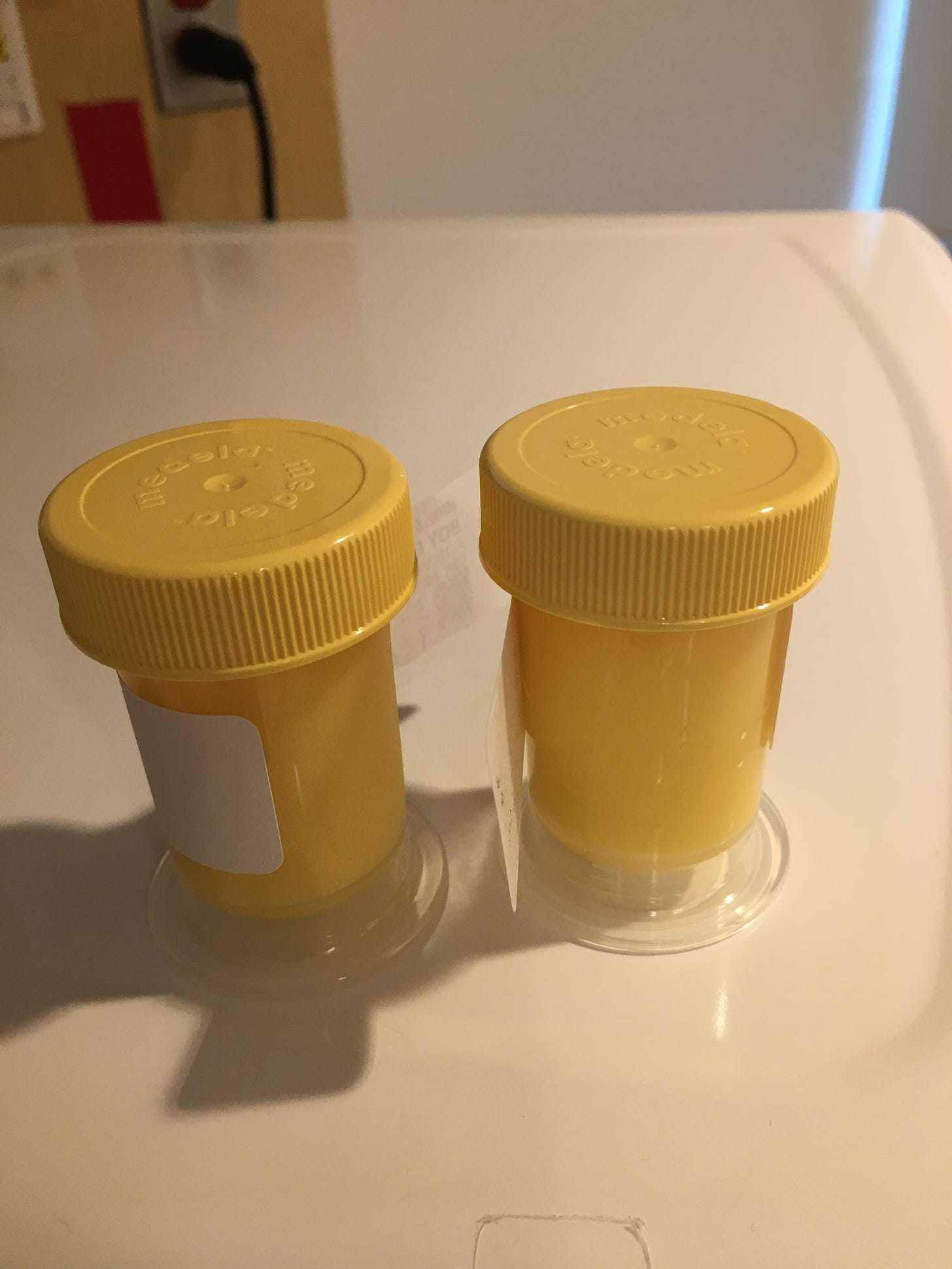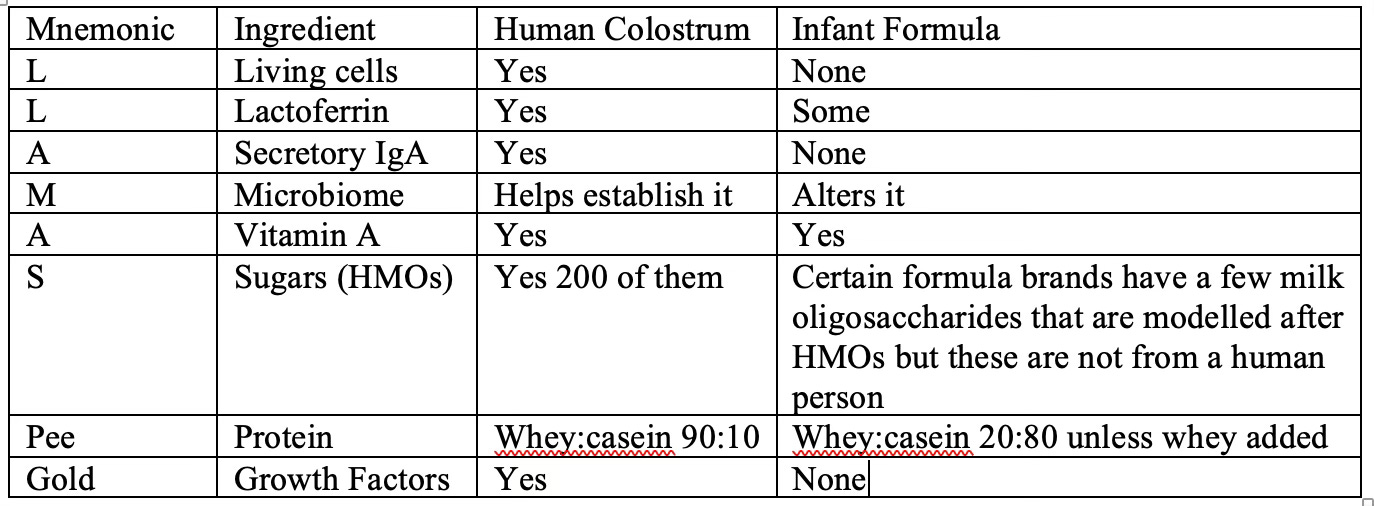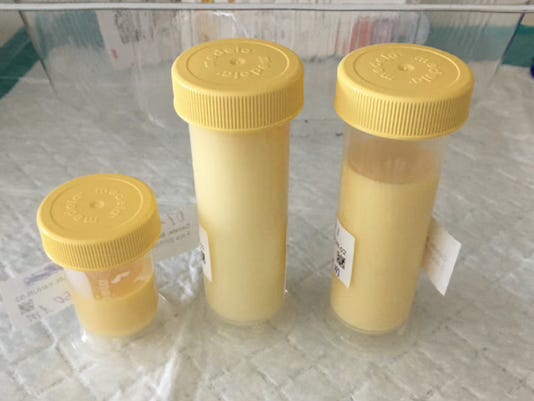Let’s begin our march through the composition of human milk. The stages in the continuum of human milk are: colostrum, transitional milk, and mature milk. This class/post begins our discussion about colostrum which will be divided into four parts.
LLAMAS Pee Gold
From this day forward, please think of LLAMAS Pee Gold when you hear the word colostrum. It’s silly I know - but it works for me and I hope for you.
Human milk, the first food, is unique and specially tailored for the needs of a human infant. Colostrum is the first, first food. Colostrum is a yellowish, thick fluid that is present for weeks before and several days after birth. The yellow color of colostrum is due to beta-carotene, a product of Vitamin A.
Colostrum is loaded with ingredients, the majority that provide infection protection to the infant. KEY POINT Indeed, the primary function of colostrum is a protective one. The secondary function is to set/seed the microbiome. A third function to provide nutrition.
The best way for me to read and REMEMBER facts is by using mnemonics. Try using the mnemonic, LLAMAS Pee Gold, to help remember special facts about colostrum, with each capital letter standing for an important ingredient or a special function.
L Living cells
Colostrum contains approximately 5 million cells per mL. This number decreases tenfold in mature human milk. The two main types of white blood cells in mother’s milk are macrophages and lymphocytes. Macrophages make up the majority of the cells at 90%. These cells engulf and absorb pathogens. Lymphocytes comprise the other 10%.
L Lactoferrin
Lactoferrin in colostrum binds and transports iron. It offers protection against infection by keeping iron away from pathogens (the bad guys). Pathogens need iron to be able to grow and multiply.
A Secretory IgA
Secretory IgA is the main immunoglobulin (antibody) in human milk and a key player in the first days. Secretory IgA is 15-40 times higher in the first 24 hours than during any other stage of lactation. We will talk much more about Secretory IgA in a later post but for this post remember that the newborn gut is permeable in the first days of life (think of it as leaky; gaps are present between the cells lining the gut). Secretory IgA coats the gut, sealing off entry points for potential pathogens. I think of it like being a varnish. Secretory IgA is a big deal because the antibodies are directed specifically against the dangerous pathogens in the mother’s environment that the infant is also exposed to.
M Microbiome
Breast milk is not a sterile liquid. Following birth, the bacteria in breast milk help the infant’s gut establish beneficial, non-pathogenic bacteria, particularly bifidus flora, which crowd out the growth of other, more dangerous bacteria.
A Vitamin A
Colostrum is high in vitamin A which gives it the yellow color and provides more immune protection to the infant.
S Sugars – HMOs (human milk oligosaccharides)
HMOs are a family of structurally diverse carbohydrates that are highly abundant in and unique to human milk. HMOs work in several ways: 1) They are a prebiotic (originally discovered as the “bifidus factor”) serving as food for “good bacteria” to help shape a healthy microbiome; 2) They serve as decoy receptors that prevent pathogens (viruses, bacteria, parasites) from attaching to infant mucosal surfaces; and 3) Working with the good bacteria, they participate in the production of sialic acid which is an essential nutrient for brain development and cognition. (Much more on HMO’s later.)
Over 200 HMOs have been discovered to date. I find it fascinating that this type of carbohydrate (sugar) is mostly not absorbed but instead remains in the gut to do its work.
P Protein
Remember the nursery rhyme, “Little Miss Muffet sat on her tuffet, eating her curds and whey?” Milk protein is made up of two types of protein: 1) whey (liquid, easier to digest) and 2) casein (curds, more solid, harder to digest). The whey: casein ratio of colostrum is 90:10 which makes it easy to digest. The whey fraction also contains all the “yum yums,” as Emeril Lagasse would say! The ratio changes in mature human milk changes to whey: casein 60:40.
Because whey is so easy to digest and because colostrum contains a lot of it, colostrum has a laxative effect – helping the newborn pass meconium – which gets the bilirubin out.
G Growth factors
As mentioned, the newborn gut is permeable. Growth factors, including epidermal growth factor, TGF-B and colony stimulating factor, are highly concentrated in colostrum and promote gut cell closure.
KEY POINT Compared to mature milk, colostrum has:
Higher concentration of protein
Lower concentration of lactose and fat
How does infant formula compare?
References
Core Curriculum for Lactation Consultant Practice, 3rd edition. Edited by Rebecca Mannel, Patricia J. Martens, and Marsha Walker. Jones & Bartlett Learning. 2013
Wambach K and Spence B. Breastfeeding and Human Lactation, 6th edition. Jones & Bartlett Learning. 2021
Bode L. Human milk oligosaccharides. Every baby needs a sugar mama. Glycobiology 2012. PMID:22513036
Tema #2. Calostro Parte 1: CLAMA LA Pera Verde
La leche materna humana, el primer alimento, es única y está especialmente adaptada a las necesidades de un bebé humano. El calostro es el auténtico primer alimento. El calostro es un líquido espeso, amarillo y de alta densidad que está presente durante semanas antes y durante varios días después del nacimiento.
El color amarillo del calostro se debe al betacaroteno. El calostro está cargado de ingredientes, la mayoría de los cuales proporcionan protección contra las infecciones al lactante. De hecho, la función principal del calostro es protectora.
Utiliza el acróstico, CLAMA LA Pera Verde, para ayudarte a recordar datos especiales sobre el calostro, donde cada letra mayúscula representa un ingrediente importante o una función especial.
C Factores de Crecimiento
Como se ha mencionado, el intestino del recién nacido es permeable (piensa que es como que tiene fugas). Los factores de crecimiento, como el factor de crecimiento epidérmico y el factor estimulante de colonias, están muy concentrados en el calostro y favorecen el cierre del intestino.
L Lactoferrina
La lactoferrina aglutina y transporta el hierro y ofrece protección contra las infecciones al mantener el hierro alejado de los patógenos que lo necesitan para crecer.
A La IgA secretora
La IgA secretora es la principal inmunoglobulina de la leche humana y es un elemento clave en los primeros días. La IgA secretora es de 15 a 40 veces más alta en las primeras 24 horas que durante cualquier otra etapa de la lactancia. Al principio, el intestino del recién nacido es permeable. La IgA secretora recubre el intestino, sellándolo ante posibles patógenos. La IgA secretora es importante porque los anticuerpos se dirigen específicamente contra los patógenos peligrosos del entorno de la madre a los que también está expuesto el bebé.
Piensa que el calostro es como un batido de proteínas salado. (Para que esto tenga sentido, hay que saber que la sal se compone de sodio y cloruro).
En comparación con la leche madura, el calostro tiene:
Mayores concentraciones de proteínas, sodio y cloruro
Menores concentraciones de lactosa y grasa
M Microbioma
La leche materna no es un líquido estéril. Tras el nacimiento, las bacterias de la leche materna ayudan al intestino del bebé a establecer bacterias beneficiosas y no patógenas, en particular la flora bífida, que desplazan el crecimiento de otras bacterias más peligrosas.
A Vitamina A
El calostro tiene un alto contenido en vitamina A, que proporciona una mayor protección inmunitaria al lactante.
L Laxante
El calostro tiene un efecto laxante que ayuda a eliminar el meconio y su reserva de bilirrubina. El calostro contiene una gran cantidad de proteína fácil de digerir, el suero de leche. La proporción entre suero y caseína en el calostro es de 90:10. Recuerda: hay un reguero de suero en el calostro.
A Azúcares - HMO (oligosacáridos de la leche humana)
Los HMO son una familia de hidratos de carbono estructuralmente diversos que son muy abundantes y exclusivos de la leche humana. Los HMO actúan de varias maneras: 1) Son un prebiótico que sirve de alimento a las "bacterias buenas" para ayudar a formar un microbioma saludable; 2) Sirven de receptores señuelo que impiden que los patógenos se adhieran a las superficies de la mucosa del lactante; y 3) Al trabajar con las bacterias buenas, participan en la producción de ácido siálico, que es un nutriente esencial para el desarrollo del cerebro y la cognición.
P Proteínas
¿Conoces la canción infantil "La señorita Mufete, sentada en un taburete, comía su cuajada y su suero"? La proteína de la leche se compone de dos tipos de proteínas: 1) la caseína (cuajada, más sólida, más difícil de digerir) y 2) el suero (líquido, más fácil de digerir). La proporción suero:caseína en el calostro es de 90:10, lo que hace que sea fácil de digerir. La proporción cambia en la leche humana madura a suero:caseína 60:40.
V Células Vivas
El calostro contiene aproximadamente 5 millones de células por mL. En la leche humana madura este número se reduce diez veces. Los dos tipos principales de glóbulos blancos de la leche materna son los macrófagos y los linfocitos. Los macrófagos constituyen la mayoría de las células, con un 90%. Estas células engullen y absorben los patógenos. Los linfocitos constituyen el otro 10%.
Referencias
Plan de estudios básico para la práctica de consultores en lactancia, tercera edición. Editado por Rebecca Mannel, Patricia J. Martens y Marsha Walker. Aprendizaje de Jones y Bartlett. 2013
Wambach K y Spence B. Lactancia materna y lactancia humana, sexta edición. Aprendizaje de Jones y Bartlett. 2021
Bode L. Oligosacáridos de la leche humana. Todo bebé necesita una mamá dulce. Glicobiología 2012. PMID:22513036








The facts are fantastic … well compiled ! Thanks for the learning mam